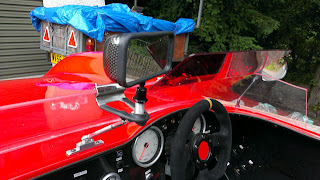I have had to make a number of modifications to the original fuel system design as a result of experience when using the car. The first sign of trouble was on my return from the IVA, I decided to top up the tank in my garage and to my horror the tank was pressurised, the cap just about blew my head off.
The second problem is the fuel gauge, despite my efforts to make it accurate, was not. It was telling me it was empty and it had 1.5Gallons left. The standard VDO gauge is 380mm and the tanks as designed is 420mm. 40mm is roughly equivalent to the error of the gauge.
I had a read at the forums particularly on the matter of pressurisation and it turns out that HP fuel systems can cause this problem particularly when there is no room for expansion in the tank and where a simple one way valve is fitted. The fuel comes back from the fuel rail slightly temperature elevated and therefore wants to expand the fuel in the tank. The one way valve compounds the problem as it is designed to let air in and not out. There is also a charging of the tank when you start the car up for the first time. Repeated start stop compounds the problem.
There is a valve called a Mocal valve that is designed to alleviate these problems as it works in both directions with limitations of course. This valve has a 0.5 bar negative inlet trigger point and a 0.75 bar positive pressure relief threshold. This is an expensive part ~£60 from various sources.
I fitted the Mocal valve and although this prevented the tank pressurising it dumped neat fuel occasionally under the car. My driveway has a 15deg slope and when driving up, the two way valve becomes temporarily blocked by fuel and then when the tank becomes pressurised it dumps neat fuel into the overflow till equilibrium is reached within the tank at 0.75 bar.
This in my opinion is an inherent problem with aero style tanks where the Mocal valve has to be connected at the same height a the top of the tank. It would be slightly easier if there was a filler neck, where no fuel was present and no fuel would be expelled.
The puma ECU has provision for a Carbon filter for such an eventuality along with a solenoid valve. When you are above a certain rev range it dumps the filtered fuel into the inlet manifold and weakens the mixture from the fuel rail. All by computer control.
I decided not to use that system as I had nowhere to put a carbon filter and I had no idea what would have happened with my variation in the design of the fuel system.
I pondered the issue for several weeks and came up with a three part solution.
* I install a fuel filler pot with a one way lead free valve from Car Builders Solution. The design of which forced a 45mm air gap at the top of the tank. No matter how hard you try it will not allow filling of the tank beyond a -45mm limit.
* Installed an overflow container with a glass bowl so I can keep an eye on any overflow events from the Mocal valve. It turns out it only overflows after driving up the driveway, after the tank has been filled and then only a very small quantity of fuel is discharged. The overflow reservoir can be emptied occasionally. Better than leaking fuel at the pits or the start line.
* Modified the VDO sender to read correctly by extending the range. I don't have any pictures of this modification, trust me it was difficult.
The overflow reservoir was made out of a large fuel filter from a large us car or lorry obtained from ebay.
 |
| Modified fuel system |
 |
| Overfill protector |
 |
| Mocal valve and overflow reservoir |
Contents
http://sylvabuild.blogspot.co.uk/2012/01/sylva-j15-is-kit-car-designed-by-jeremy.html













